Derived from the Sanskriti language, Aarti (ਅਾਰਤੀ) means the light, or the vessel containing it, which is waved before an idol, generally in the clockwise direction. It is usually accompanied by the chanting of mantras. This is also the name given to a Hindu ceremony which is a mode of ritual worship to please the deity. In the Sikh faith, which totally rejects image-worship, there is no permission for this form of worship.
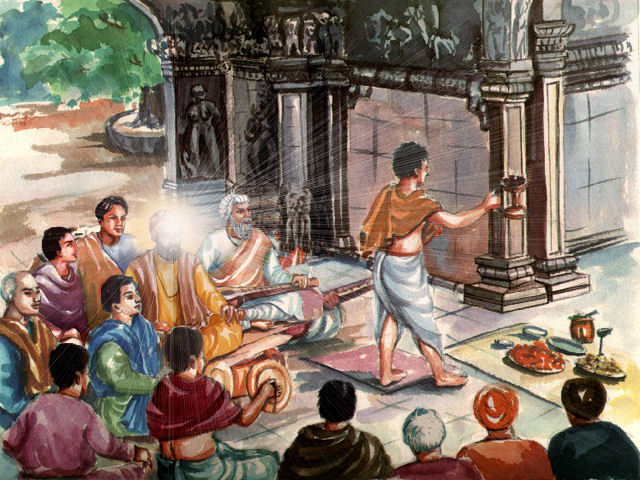
According to the Janam Sakhis, Guru Nanak Dev Ji accompanied by Bhai Mardana Ji, stopped near the temple of Jagannath, which is dedicated to Hindu god Vishnu. Guru Nanak Dev Ji and Bhai Mardana Ji stopped near the shrine upon which sat centuries of history mute and immobilized. The notes from Bhai Mardana’s Rabaab (rebeck) touched the devotees’ hearts with fresh fervor. Several of them came to hear the Guru’s word. The temple priests felt angry and held the Guru Ji guilty for not making adoration to the deity within the sacred enclosure. The local chief whose name has been described, as Krishan Lal one day visited the Guru and invited him to join the aarti, or the evening service of lights, in the temple. The Guru readily offered to go with him.
As dusk fell, the priests lighted the lamps and sumptuous ritual for which the devotees had been waiting began. Twinkling lights fed by ghee were placed on a jewel studded salver, amid flowers and incense, and worshipfully swung from side to side by the priest in front of the enshrined image to the accompaniment of the chanting of hymns, blowing of conchs and the ringing of bells. The priests had a complaint as they concluded. The Guru had remained seated in his place and not participated in the ceremony. The Guru burst into a divine song:
ਧਨਾਸਰੀ ਮਹਲਾ ੧ ਆਰਤੀ
ੴ ਸਤਿਗੁਰ ਪ੍ਰਸਾਦਿ ॥ਗਗਨ ਮੈ ਥਾਲੁ ਰਵਿ ਚੰਦੁ ਦੀਪਕ ਬਨੇ ਤਾਰਿਕਾ ਮੰਡਲ ਜਨਕ ਮੋਤੀ ॥
ਧੂਪੁ ਮਲਆਨਲੋ ਪਵਣੁ ਚਵਰੋ ਕਰੇ ਸਗਲ ਬਨਰਾਇ ਫੂਲੰਤ ਜੋਤੀ ॥੧॥
ਕੈਸੀ ਆਰਤੀ ਹੋਇ ਭਵ ਖੰਡਨਾ ਤੇਰੀ ਆਰਤੀ ॥
ਅਨਹਤਾ ਸਬਦ ਵਾਜੰਤ ਭੇਰੀ ॥੧॥ ਰਹਾਉ ॥
The sky is the salver
And the sun and the moon the lamps.
The luminous stars on the heavens are the pearls.
Scented air from the sandal-clad hills is the incense,
The winds make the fan for Thee,
And the vast forests wreath of flowers.
The unstruck music of creation is the trumpet.
Thus goes on the Arati (adoration) for Thee,
O’ Thou dispeller of doubt and fear!
Guru Nanak Dev Ji taught the listeners, how Nature’s tribute to the Creator was superior to any ritualistic oblation offered before images.
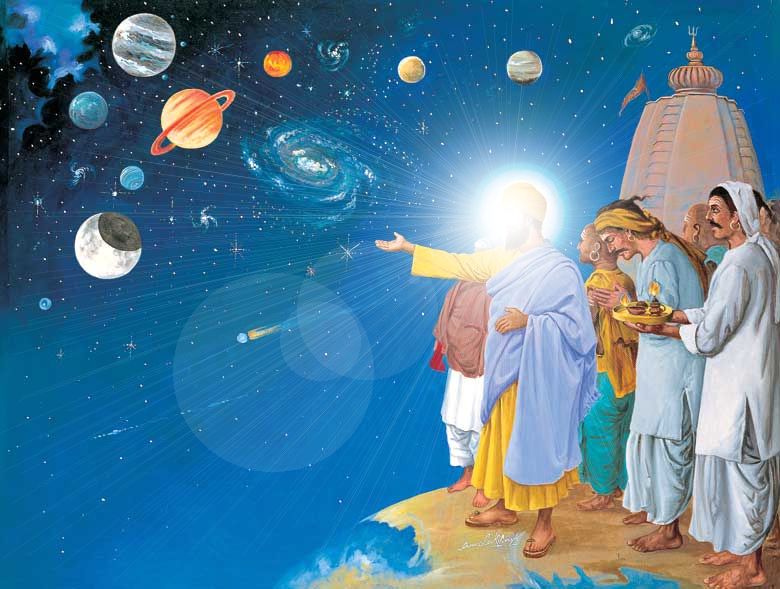
Aarti in Sikhi
Every evening in all Gurudwaras, after the recitation of Rehraas Sahib, the Keertan (singing) of Aarti through Gurbani shabads is performed by Raagis (musicians). This is a tremendously soothing experience, capable of taking us directly into the spiritual realms of devotion through music.
Bhai Gurdaas Ji writes:
ਸੋਦਰੁ ਆਰਤੀ ਗਾਵੀਐ ਅੰਮ੍ਰਿਤ ਵੇਲੇ ਜਾਪੁ ਉਚਾਰਾ||
“Sodar (Rehraas) and Aarti were sung (in the evening) and in Amrit-veal (the ambrosial hours) Japji (Sahib) was recited.”
Once actor Balraj Sahni asked the late Nobel Laureate Rabindra Nath Tagore, “You have written the national anthem for India. Can you write an international anthem for the whole world?” “It has already been written, not only international but for the entire universe, in the 16th century by Nanak,” replied Tagore. He referred to the Sikh aarti (ceremony of light). Tagore was so enamoured of this universal aarti that he personally translated it into Bengali.
Sanaatan (Hindu) practices infiltrating Sikhi
In the mid-18th century when the Khalsa had to live in the jungles because they had a price on their head, Nirmala and Udaasi Mahants (caretakers) took care of the Gurdwaras. During this period the Nirmala and Udaasis came under the influence of Hinduism and introduced Hindu practices to Sikh institutions. Over time the Mahants became more powerful and although the Sikh Gurdwaras were freed from the clutches of the corrupt Mahands in the turn of the 20th century through the Singh Sabha and Gurdwara Reform Movements.
Although the Gurdwaras were freed and Sikh Maryada (Code of Conduct) was re-introduced to Sikh institutions, some Sikh institutions in India that were outside of the Punjab or in the hands of certain Nihangs or Sants continued practicing some Hindu rituals. One of the rituals is “performing” Aarti. Singing the Keertan of Aarti is a Sikh practice, however performing Aarti by waving a platter with oil lamps and flowers whilst ringing bells is a Hindu practice.
Aarti and Sikh Maryada
The Panthic Sikh Rehit Maryada, the official Sikh Code of Conduct, states:
ਸ) ਉਪਰ ਦੱਸੇ ਸਾਮਾਨ ਤੋਂ ਇਲਾਵਾ ਧੂਪ ਜਾਂ ਦੀਵੇ ਮਚਾ ਕੇ ਆਰਤੀ ਕਰਨੀ, ਭੋਗ ਲਾਉਣਾ, ਜੋਤਾਂ ਜਗਾਉਣੀਆਂ, ਟੱਲ ਖੜਕਾਉਣੇ ਆਦਿ ਕਰਮ ਗੁਰਮਤਿ ਅਨੁਸਾਰ ਨਹੀਂ[ ਹਾਂ, ਸਥਾਨ ਨੂੰ ਸੁਗੰਧਿਤ ਕਰਨ ਲਈ ਫੁੱਲ, ਧੂਪ ਆਦਿ ਸੁਗੰਧੀਆਂ ਵਰਤਣੀਆਂ ਵਿਵਰਜਿਤ ਨਹੀਂ[ ਕਮਰੇ ਅੰਦਰ ਰੌਸ਼ਨੀ ਲਈ ਤੇਲ,ਘੀ ਜਾਂ ਮੋਮਬੱਤੀ, ਬਿਜਲੀ, ਲੈਂਪ ਆਦਿ ਜਗਾ ਲੈਣੇ ਚਾਹੀਦੇ ਹਨ |
d. Anything except the afore-mentioned reverential ceremonies, for instance, such practices as the Aarti (waving of a platter with burning lamps and incense set in it in vertical circular motion) with burning incense and lamps, offerings of eatables to Sri Guru Granth Sahib Ji, burning of lights, beating of gongs, etc., is contrary to Gurmat (the Guru’s way). However, for the perfuming of the place, the use of flowers, incense and scent is not barred. For light inside the room, oil or butter-oil lamps, candles, electric lamps, kerosene oil lamps, etc., may he lighted.
In the same spirit, Sant Gurbachan Singh Bhindranwale, a Gurbani scholar and saint, clearly explains what Aarti means in the Sikh religion in ‘Gurbaani Paath Darpan’. In chapter of Akhand Paath maryada, page 168, Sant Ji writes:
ਆਰਤੀ ੳਚਾਰਨੀ, ਦੀਵੇ ਨਹੀਂ ਬਾਲਣੇ,ਕੇਵਲ ਸ਼ਬਦ ਪੜਨੇ ਅਤੇ ਕੀਰਤਨ ਕਰਨਾ, ਫਿਰ ਕੜਾਹ ਪ੍ਰਸ਼ਾਦ ਵੰਡਣਾ ਅਤੇ ਖੁੱਲਾ ਲੰਗਰ ਕਰਨਾ।
“Do Aarti, don’t light lamps, only read Shabads of Aarti and Do Kirtan, then distribute Karah Parshaad and have open Langar.”
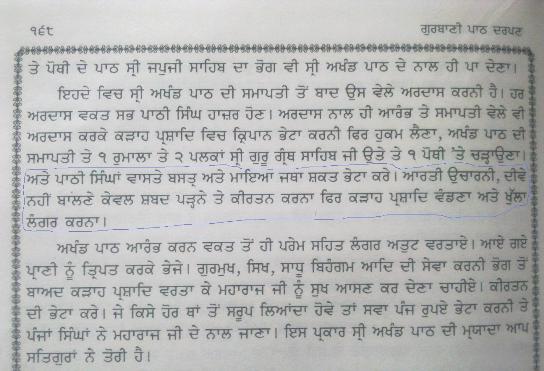
On page 135, Sant Ji writes:
ਹਰ ਪਾਠ ਦੇ ਭੋਗ ਪੈਣ ਤੇ ਕੀਰਤਨ ਤੇ ਆਰਤੀ ੳਚਾਰੇ( ਬਿਨਾਂ ਮ੍ਰਿਤਕ ਪਹਿਲੀ ਵਾਰ ਦਾ)
(ਨੋਟ- ਆਰਤੀ ਦੇ ਸ਼ਬਦ ਹੀ ੳਚਾਰਨੇ, ਦੀਵੇ ਨਹੀਂ ਬਾਲਣੇ)
“At bhog of every Paath, do Kirtan and sing Aarti (except first path of an individual’s death”
(Note- Only Sing Shabads of Aarti, don’t light lamps)
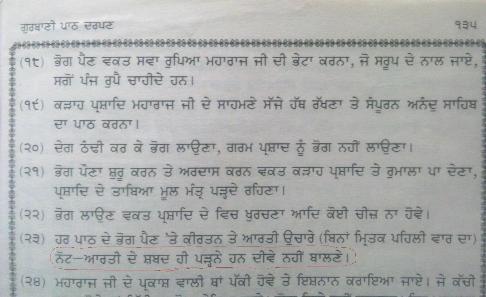
Under title of Aarti, Santji wrote complete Maryada of Aarti and in the end he writes-
ਆਰਤੀ ਦੇ ਸ਼ਬਦ ਬੈਠ ਕੇ ਪੜਨੇ ਕੀਰਤਨ ਕਰਨਾ ਹੀ ਯੋਗ ਹੈ।ਥਾਲ ਵਿਚ ਦੀਵੇ ਬਾਲ ਕੇ ਆਰਤੀ ਦਾ ਖੰਡਨ ਸਤਿਗੁਰਾਂ ਨੇ ਕੀਤਾ ਹੈ।
“It is best to sit and sing Shabads of Aarti. Doing Aarti with lighted lamps in plates has been rejected by Satguru Ji.”
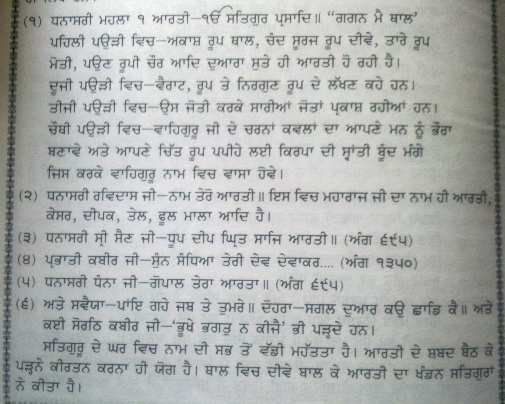
So going by Gurmat and Gurbani, only the sitting and singing of Aarti in Keertan form without lighting lamps is permissible, as lighting of lamps like the Hindus did at Mandir in Jagannath is contrary to teachings of Sri Guru Granth Sahib Ji.